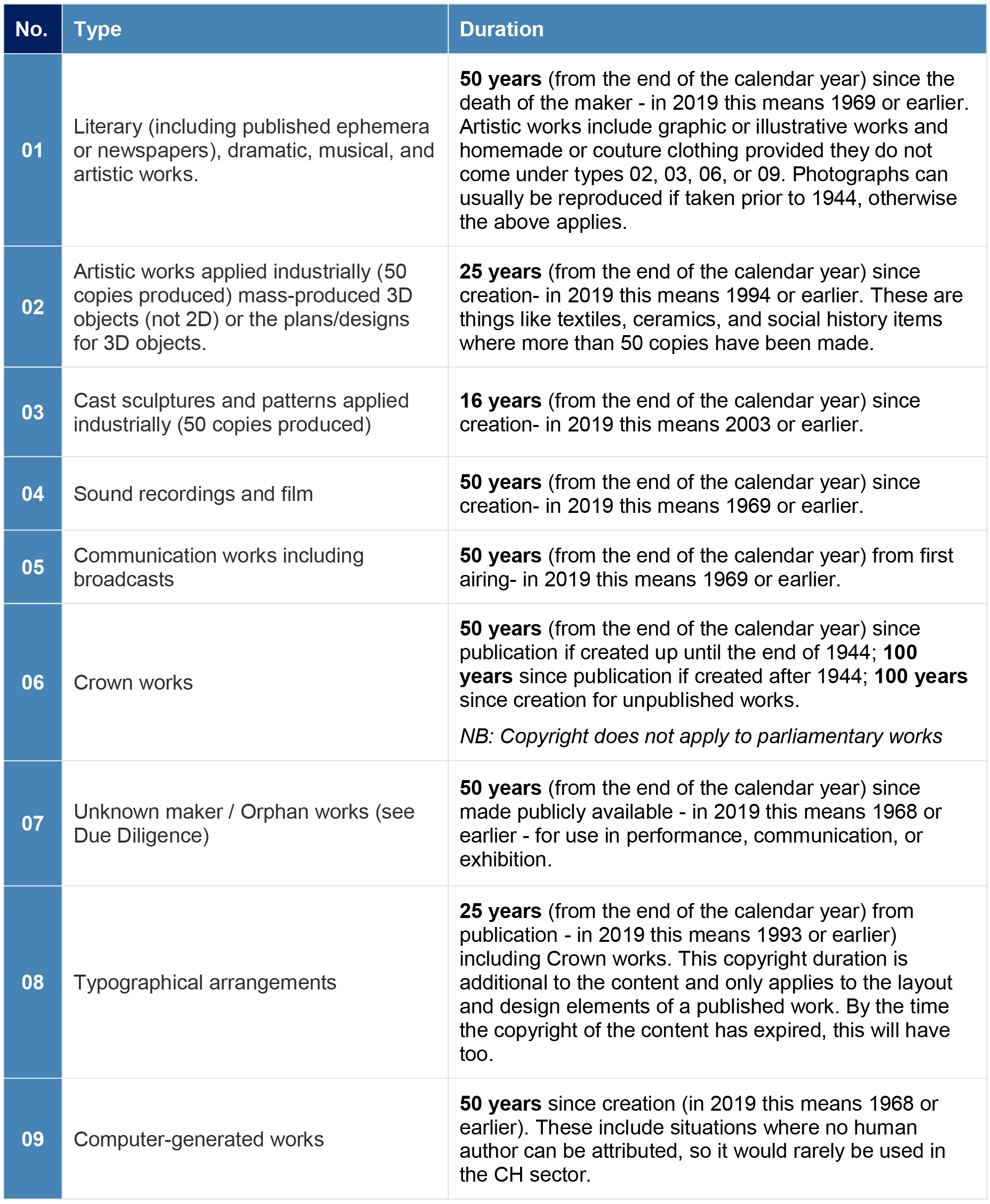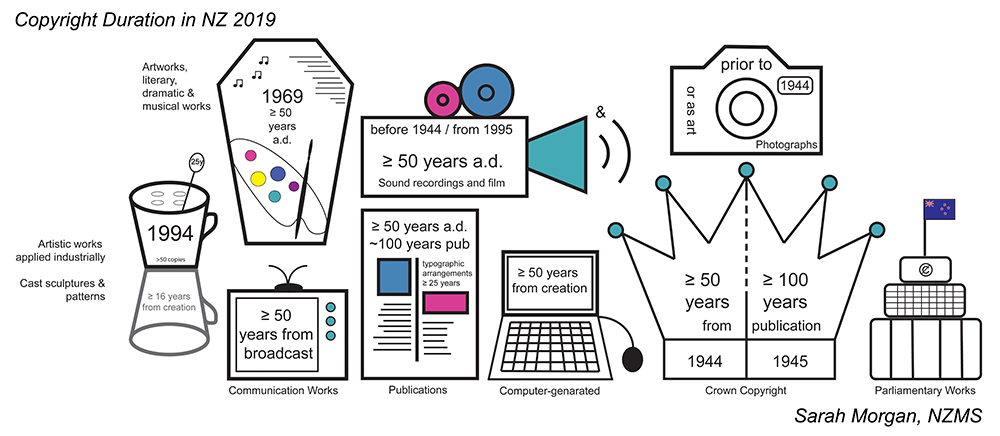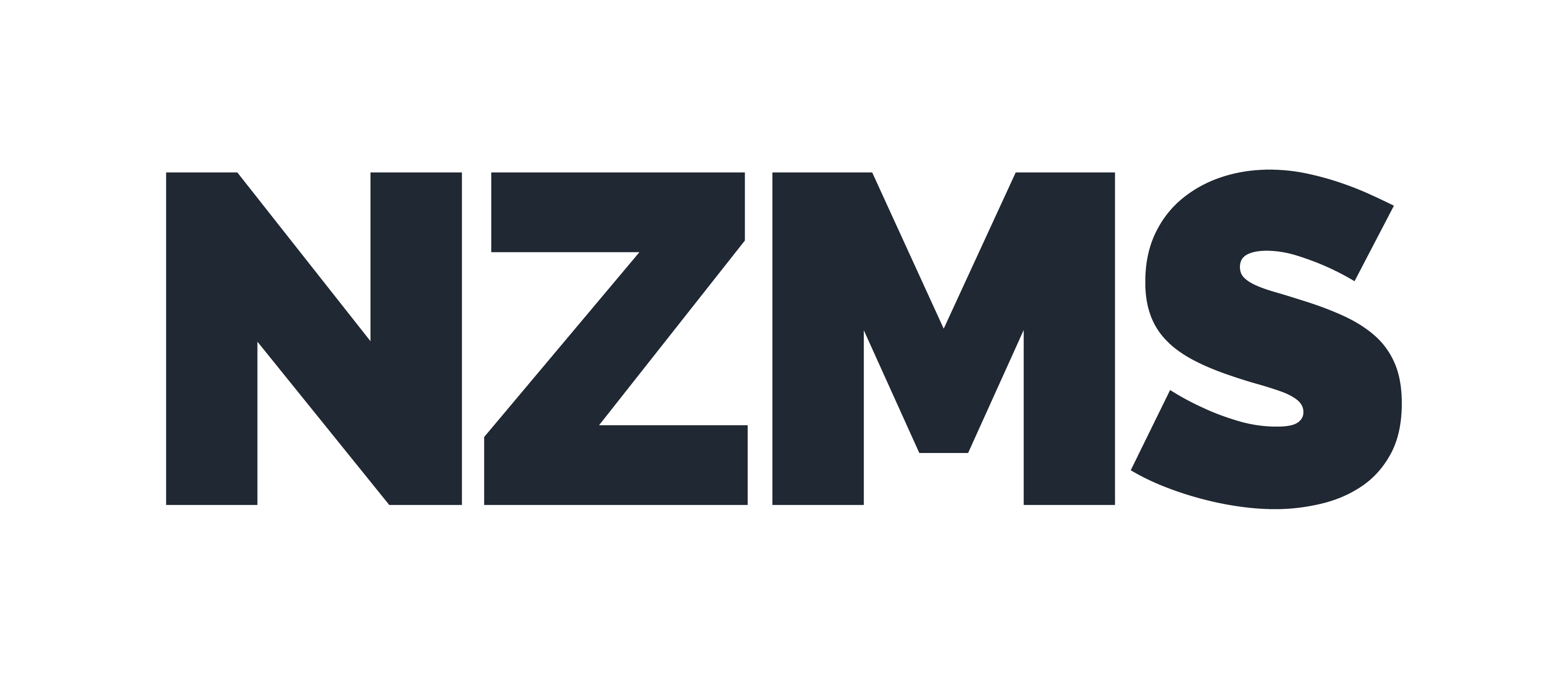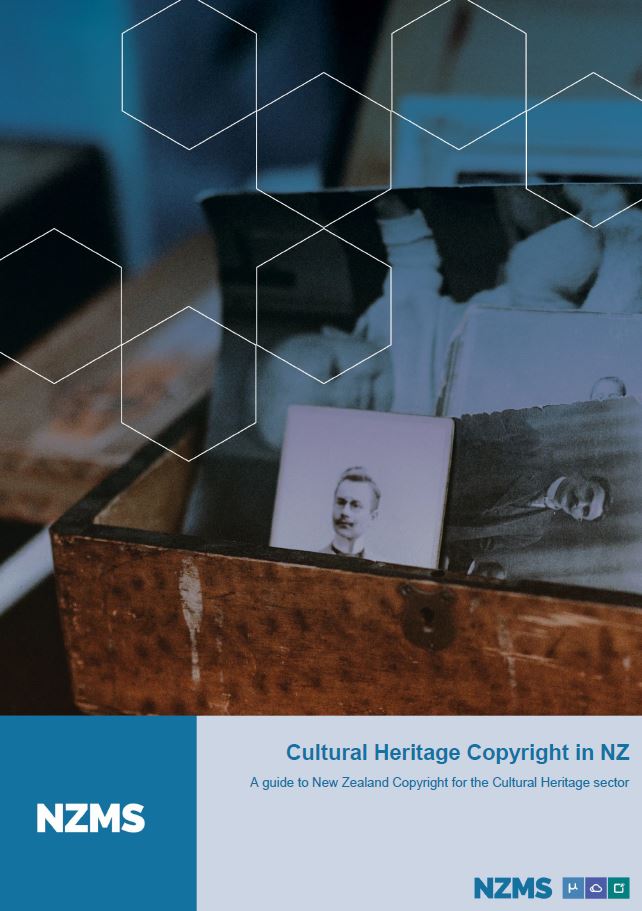A guide to New Zealand Copyright for the Cultural Heritage sector
Cultural Heritage Copyright in NZ
Understanding what copyright is, and what it means for different organisations, is an important topic for everyone in the Cultural Heritage (CH) sector to consider. In short, Copyright is the legal right to control the reproduction/copying of an original work.
This resource is a guideline only and introduces the nuances of copyright relevant to the CH sector in New Zealand. While it will be useful as a first point of call, particularly for individuals or small institutions, we strongly recommend that further research is conducted for more complex copyright queries.
Here at NZMS, our terms and conditions specify that the client is responsible for establishing copyright clearance, where required, for any digitisation or reproductions we produce.
Creating or interacting with copies of an original work is an inevitable component of working in the CH sector. These interactions are usually for in-house purposes including: catalogues, marketing, reproductions for exhibitions, or even external requests from visitors for a digital copy of an item.
The Copyright Act (1994) governs copyright in New Zealand, defining the duration of copyright, copyright holders, which rights can be reassigned or traded, and what is deemed infringement. Copyright laws vary overseas. The copyright law applies to where the work is being copied. Infringing copyright is an offence, so it is important that the CH sector follow best practice by receiving permission from creators or owners to reproduce work when required. If a copyright infringement occurs, the copyright holder can seek significant compensation and damage the reputation of you or your institution.
Cultural Heritage collections often contain numerous copyright issues, so we stress that this information is only used as a guide. Please note this guide aims only to be an introductory overview into copyright issues for the CH sector. Where possible, links have been provided for further reference after the conclusion.
NZMS would like to acknowledge Sarah Morgan (NZMS Digitisation Technician) for her contributions to this resource. She has a considerable amount of experience working with copyright in the CH sector and it is a strong point of interest for her.
Copyright Holders
What is copyright?
Copyright is the right to control the reproduction and use of original work. Copyright is an intellectual property right. In New Zealand, copyright does not require registration because it is automatically attributed to the creator – provided those works are within the types described in the table below or in Section 22: Copyright Act 1994. When you are not the copyright holder it is essential to request permission for when reproducing a work in copyright. Where you are displaying an original work, you are not required to receive permission from the copyright holder to display it. Copyright can be held by individuals and/or organisations. In this resource, we use terms such as ‘in/out’ of copyright. These terms are used to describe when an item either has copyright law protecting its reproduction (in/under copyright) or if it is in the public domain (out of copyright).
What is not covered by copyright?
- Intangible ideas
- Facts
- Natural objects
- Copyright is distinct from moral or ethical rights which should still be considered when reproducing works.
- Notably, mātauranga Māori (Māori knowledge in relation to cultural customs) should be taken into account when reproducing taonga and should be done so collaboratively with local iwi and / or hapū representatives.
Who owns copyright?
Unless agreed to otherwise:
- Creator(s) in the first instance.
- The Commissioner of the work.
- Employer (where an employee creates the work).
- Joint ownership: just as there can be different types of media within one work, there can also be multiple creators, and this means there are sometimes multiple copyright holders as well (see section below on multiple copyright holders).
What happens once the creator dies?
It passes down automatically to the next of kin (unless specified otherwise in a legal agreement such as a Will).
There are some occasions where the creator of a work is not the first copyright holder:
- Commissioned works: the commissioner is the copyright holder.
- Works by employees: if the work is created during their employment the employer is the copyright holder.
Commissioned works and works by employees apply as stated above, unless agreed otherwise. For example, although a studio portrait is commissioned by an individual, the photographer’s contract may stipulate that they, the photographer, are the copyright holders of the images (for use in their portfolio etc.).
Owning an item Vs. Holding the copyright
It is important to clarify the difference between owning an item and holding the copyright for it.
- If you are the sole creator of a work and it is in your possession, then you can be the owner as well as the copyright holder. If it is sold or gifted, then you (the creator) maintain copyright of the work even though it is no longer owned by you.
- If you buy or are given a work, you are not the copyright holder as you did not create it. This prevents the ‘owner’ from making copies and reproducing the work without the copyright holder’s permission.
- If you inherit a work from its creator or the previous copyright holder (provided the duration of copyright is still in play) as next of kin, then you are now the copyright holder of the work, as well as the owner.
- If you inherit a work from its owner (who is not the creator) and the work is still in copyright, then you require permission from the copyright holder to produce copies of the work outside of personal use.
- If you own a work that is in copyright and did not create it, you are legally obligated to obtain permissions from the copyright holder to reproduce the work.
Unknown copyright holders
Works, like photographs, paintings, films, audio etc. may have an unknown maker and production date, which means it can be difficult to establish who the copyright holder is. It may be possible to identify the maker through associated paperwork or catalogue records – there you can determine if there are any notes referencing the copyright status of the work or details surrounding the maker/lender/subject.
Once you have a fair assumption of who the creator of the work is, your records and / or database might be of help finding their contact details or other information. There are many helpful directories to assist in locating names and /or contact information beyond social media such as, electoral rolls, genealogy sites, obituaries, Papers Past, and The Companies Office.
Orphan works are works which are assumed to be in copyright where it has not been possible to identify, locate or contact the copyright owner. You are required to do due diligence when investigating copyright holders prior to any reuse.
Further resources for identifying copyright holders can be found in the references.
Due diligence
If reproducing work with no known copyright holder, you must be able to legally prove that you took every opportunity available to identify, locate, and request permissions for the work prior to reproduction. This means you are required to document your efforts in writing. This documentation is then there as a potential defence should legal proceedings be brought against you. Assess this risk with considering your reputation, relationships with other institutions, and monetary penalisation. Be aware that copyright infringement can result in fines of up to $50,000 in New Zealand. If you do choose to proceed, it is advised that you include a takedown notice, for example: If there is any content that you believe to be infringing copyright or in breach of a legal agreement please notify [contact details of the relevant person at your institution].
Multiple copyright holders
In many works, particularly audio-visual material, there are multiple copyright holders. This means you must receive permission from each of the copyright holders to reproduce or use the work.
Examples of works that may have multiple copyright holders:
- An illustrated book could have copyright attributed to the publisher, author, and the illustrator.
- Publications with joint authors and editors.
- Audio-visual works – producer and director.
- Music – the record label, the recording artist(s), and collaborators.
The film and music industries will usually require your institution to obtain licences to screen and play material. These licences can be granted through organisations such as, One Music and APRA AMCOS. Additional permissions may also need to be granted, particularly for internationally produced material. Where a license is required to use books, magazines and newspapers, Copyright Licensing New Zealand is a good place to start.
Copyright Duration
How long does copyright last?
Duration and ownership of copyright are separate. The duration that a work is in copyright is dependent on the type of work. The following table and infographic help to depict copyright duration in New Zealand as of 2019.
To use a work without legally requiring express permission from the copyright holder, it must be deemed out of copyright and the following conditions must apply:
This table prioritises the types of work that are pertinent to the Cultural Heritage sector. Please see the complete list here: Duration of Copyright – Section 22: Copyright Act 1994


Note: The above applies for works created in New Zealand only. Many of the works in New Zealand collections are made overseas and might have longer durations within that country’s copyright legislation. In many other countries, including the USA and Europe, the duration is 70 years instead of 50 years. The commissioning rule is also reversed overseas, for example, the creator holds copyright by default, not the commissioner, unless agreed otherwise.
It is also important to note that due to the CPTPP, the duration of copyright may be extended to 70 years (although it is not required at this stage). However, The Copyright Act is under review and this could generate significant changes to copyright legislation in the near future.
Reproductions and Copyright
Copyright clearance
Obtaining copyright clearance to reproduce a work is a legal requirement under the Copyright Act. Permission should be obtained prior to reproducing the work outside of personal use. Written permission should be attained at the very least, although a signed clearance form is preferable because it is legally binding. This will be useful if an alleged claim of copyright infringement occurs – which can arise during disputes over who the legal copyright holder is.
Personal use, research and education
It is becoming common for New Zealand CH copyright clearance forms to be for non-commercial use only – such as reproducing the object for museum or administration purposes. If a copy of a work, still in copyright, is published or used within a commercial environment, express written permission from the copyright holder is required prior to use.
Copies can be made without clearance only under strict conditions:
- A single copy for personal use and research – unpublished use. This excludes use on social media, as this is deemed publishing.
- Education – copies can be made for educational purposes within a classroom setting.
- Works out of copyright/in public domain.
- Orphan works
- Works licensed under Creative Commons copyright licences (see below).
- Works with unidentifiable copyright holders (see Due Diligence section).
Note: special moral permissions apply to works deemed taonga in recognition of cultural sensitivity. This generally means contacting an internal Māori advisor as well as the relevant iwi / hapū / whānau. For further information, see the resources after the conclusion.
Originals, reproductions, or replicas
In the CH sector, reproductions or replicas are frequently used in place of the original work, especially in exhibitions, where there is the risk that the item could be damaged. Copyright permissions are not required unless displaying that item is outside of any legal agreement (stipulated in things like the loan agreement or acquisition parameters).
Reproductions are a good option for collection management purposes, because they can usually be done in-house and they ensure a record of the item is available for cataloguing – this undoubtedly reduces the risk of damaging the original work.
Replicas are a good compromise between reproductions and the originals, but they often require specialists and can be costly to produce.
Social media
Social media and the prevalence of portable digital imaging equipment means there is now an expectation that visitors can photograph and film exhibits. Developing a social media policy can be beneficial to regulate how this expectation is managed by your institution.
This might include developing legal permission forms to send to copyright holders that outline all the possible contexts needing clearance, like administration, marketing, and social media.Ideally, all copyright holders will agree to their work being used on social media – but this often isn’t the case. If permission is unattainable, which is often the case for items like taonga, only the original work can be displayed and should be clearly labelled with the universal ‘photography forbidden’ symbol.
Status, statements & creative commons
Copyright status
Ideally, copyright status should be stated in your CMS/catalogue record. The following are examples of copyright statuses:
- Out of copyright/public domain:
You are free to reproduce an image without seeking permission. Keep in mind that ethical considerations may still apply in some cases, like taonga.
- Non-commercial/website:
Clearance has been received to reproduce this work for non-commercial museum related purposes.
- Commercial:
Permission has been gained to reproduce the work for profit – generally within specific parameters such as a particular publication.
- Copyright restrictions apply:
The work is still in copyright – clearance forms must be signed and received prior to reproducing the image.
- Special conditions:
Flagged – paperwork will specify the conditions.
Note: If the work is being reproduced for anything outside of the parameters set out in the associated clearance forms or loan agreement, then a new request needs to be made to the copyright holder and agreed to in writing.
Rights statements
Digital copies of works in an online collection database can be attributed with rights statements. Rights statements indicate to online visitors the copyright status of each image. These statements can be developed in relation to your content where appropriate. For pre-existing examples: Te Papa, Auckland Museum.
Creative Commons
Creative Commons (CC) was primarily established for artists to share their work more freely online. A Creative Commons license should only be assigned to a work by the copyright holder or outlined in a written agreement with them.
CC Licenses are represented by the following symbols:

Attribution
Tautohu Matatiki

Non-commercial
Arumoni Kore

No Derivatives
Taketake Anake

Sharealike
Tiritiri Raihana
CCBY 4.0 Creative Commons
The resulting licenses are:
- Attribution
- Attribution-Noncommercial
- Attribution-Sharealike
- Attribution-Noncommercial-Sharealike
- Attribution-No Derivatives
- Attribution-Noncommercial-No Derivatives
All licenses require that you credit the copyright holder of the work and that the licence travels with the copy.
- Licenses 1,2,3,4 let you “remix, tweak, and build upon your work”
- Licenses 1,3,5 can be used commercially
- Licenses 2,4,6 can only be used in a non-commercial context
- Licenses 1,5,6 allow for direct redistribution of the original
- Sharealike licenses must retain the same license attributed by the initial rights holder
- No derivative licenses do not allow you to alter the original work
See the NZ Creative Commons site here: https://www.tohatoha.org.nz/
See the international Creative Commons site here: https://creativecommons.org/
Conclusion
Copyright is a complex issue, particularly for the cultural heritage sector. The most important piece of advice regarding copyright is to ensure any and all agreements are clear and in writing. Where any of the terms of an agreement have changed, especially in relation to how reproductions are being used, you need to request new permissions that allow for these changes. Where you or your institution are unsure whether reproductions are in breach of copyright, it is best not to proceed, or seek further advice from industry experts. The resources below should assist you in securing that advice. Make sure you allow time within your schedule to clear copyright prior to producing and using reproductions of works in copyright as it can be an onerous task.
Reference and More Information
Primary Reference
Guides
- National Services Te Paerangi: Copyright and Museums
- The University of Auckland Te Whare Wānanga o Tāmaki Makaurau: About copyright
- Digital New Zealand: Enabling Use & Reuse
- New Zealand Intellectual Property Office: Copyright
- Copyright Licensing New Zealand
- National Library: Copyright and Privacy
- Te Papa’s Copyright Duration Flowchart
- NZ Intellectual Property Office – Māori IP
Further Resources
For identifying copyright holders:
For a place to discuss copyright queries: Aotearoa GLAM Copyright on Loomio
For information on Creative Commons Licenses: Creative Commons Global Network
For Rights Statements examples: Te Papa and Auckland Museum
For music and audio-visual licenses: One Music and APRA AMCOS
New Zealand Foreign Affairs & Trade Manatu Aorere: Understanding CPTPP: Intellectual Property

